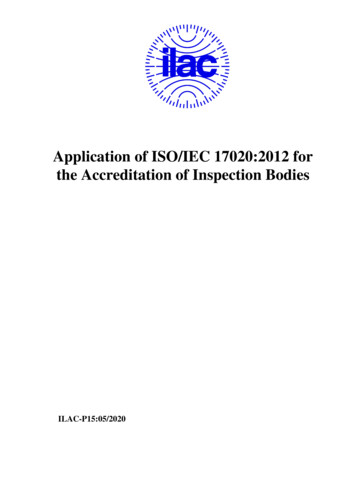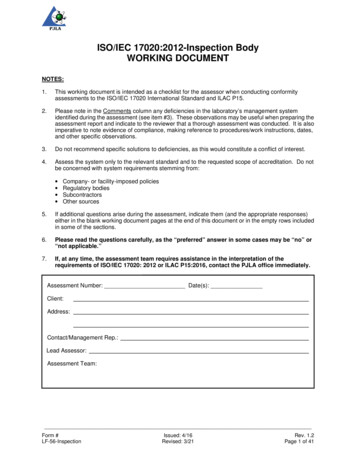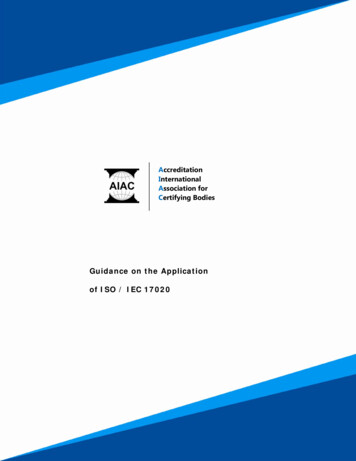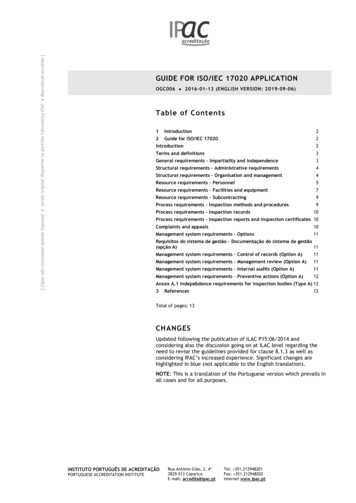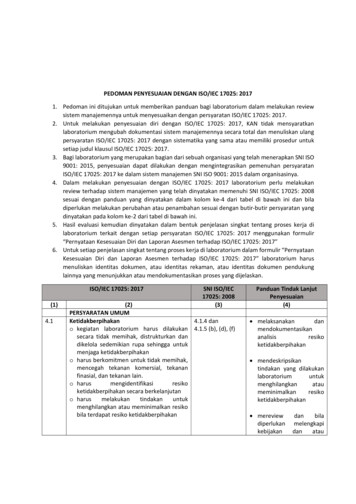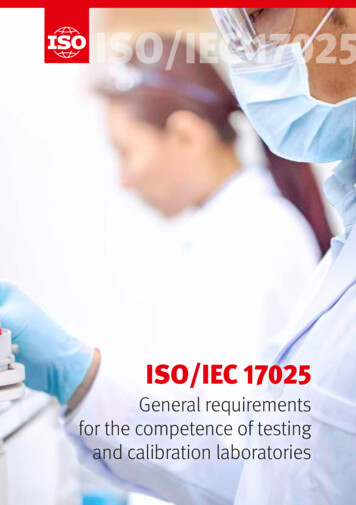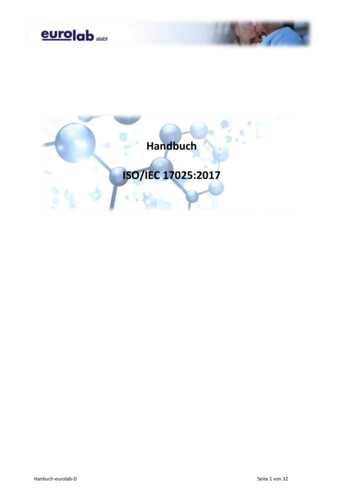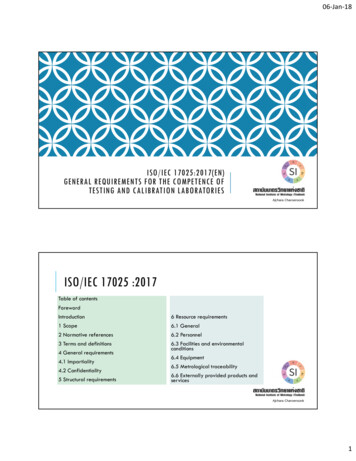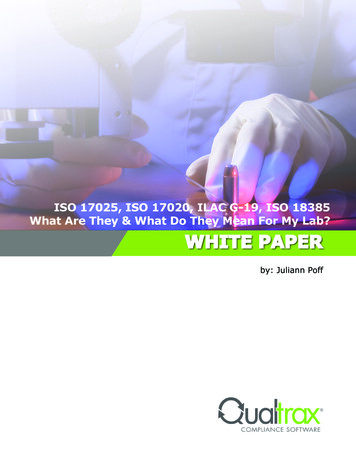
Transcription
ISO 17025, ISO 17020, ILAC G-19, ISO 18385What Are They & What Do They Mean For My Lab?WHITE PAPERby: Juliann Poff
ISO 17025, ISO 17020, ILAC G-19, ISO 18385by: Juliann PoffQualtrax, Inc.Value of AccreditationAll of these acronyms and numbers are sets of standards to ensure that requirements,specifications, guidelines or characteristics are followed. Laboratories are accredited to one ormore of these standards for the work that they perform.So what is the value of accreditation? By definition, accreditation is the process of formalrecognition for competence to perform specific tests conducted by an independent third partyusing a defined set of standardsThe ISO standards include two core elements to help organizations: The QualityManagement System and the Technical Aspects that are relevant to that industry.The Quality Management System includes policies, document control, nonconforming work,preventive actions, control of records, and management review. The second part is theTechnical Aspects, including personnel qualifications and training (ongoing competency),procedures on evidence, scientific validation, storage, and examination, security of recordsand proper functioning of equipment, and documented agreements that contain technicalspecifications or other precise criteria. These are used consistently as rules, guidelines, ordefinitions of characteristics to ensure that materials, products, processes and services arefit for their purpose.Find the Best FitSo which accreditation should I pick for my laboratory? Is one better than the other? Whatmatters most is which one fits you best based on the type of testing you are doing.Accreditations for forensic laboratories include: ISO/IEC 17025 – labs, ISO/IEC 17020 inspection bodies, ILAC G19:08/2014 – Guidelines for Forensic Science Laboratories, FBI –Quality Assurance Standards, NAME – Medical Examiners, ABFT – Forensic Toxicology. All ofthese standards have equal weight. Each is designed to meet certain conditions, anddepending upon the situation, one may be more appropriate than the other.In the ISO world, inspection overlaps with testing. Inspection often involves examination,measurements, testing, and/or comparison of materials or items. Many types of inspectionsinvolve professional judgment to determine acceptability against requirements. There is noanalytical data generated by analytical instrumentation. Both standards have similarmanagement requirements based on ISO 9001 (Section 4 in ISO/IEC 17025 and Clause 8in ISO/IEC 17020). ISO/IEC 17025 is the standard for testing and calibration (metrology)laboratories and ISO/IEC 17025 isappropriate for analytical chemistrytesting laboratories and are usinganalytical instruments to make theirconclusions. ISO/IEC 17025 is heavyin measurement uncertainty,traceability, and analytical validation.
ISO 17025, ISO 17020, ILAC G-19, ISO 18385by: Juliann PoffQualtrax, Inc.ISO/IEC 17020 is the standard for inspection bodies and is designed for the inspectionprocess where conclusions are made based on professional judgment. In the ISO/IEC 17020standard for forensic agencies, the term Inspection applies to crime scene investigationsand/or examination of forensic evidence. The term Inspector then applies to an examiner oranalyst who uses professional judgment to examine or inspect evidence with the aim todetermine if the comparison between items meets certain criteria. The term Inspector alsoapplies to an investigator who uses professional judgment to examine a crime scene with theaim to contribute to determining what, where, when, how, and why something happened andwho was involved.ILAC G19, Modules in a Forensic Science Process, is a guidance document intended to provideguidance for forensic science units involved in examination and testing in the forensic scienceprocess for both of ISO/IEC 17025 and ISO/IEC 17020. It helps provide further clarity forlaboratories, crime scene investigation units, and other forensic units. Some accrediting bodieshave adopted the elements of G19 as forensic supplemental requirements and include them intheir checklists. These standards also help to ensure that when collecting samples at a crimescene that they are collecting the samples according to accepted procedures since that is thedata to analyze. A forensic laboratory would be accredited to ISO and then also guide 19.Your lab functions as long as you do what you say and say what you do, and it does not affectthe quality of the output. If you don’t, you are at risk of having errors or could jeopardize theresults.In the United States we also have the FBI’s Quality Assurance Standards (QAS) for laboratoriesperforming forensic DNA testing or utilizing the Combined DNA Index System (CODIS). Thus isit not necessary that forensic labs in other countries adhere to the FBI’s QAS. However, somecountries will use these as a guide as they may not have an alternative available.NAME (National Association of Medical Examiners) standard. NAME was founded in 1966 withthe dual purposes of fostering the professional growth of physician death investigators anddisseminating the professional and technical information vital to the continuing improvementof the medical investigation of violent, suspicious and unusual deaths. Growing from a smallnucleus of concerned physicians, NAME has expanded its scope to include physician medicalexaminers and coroners, medical death investigators and medico legal system administratorsfrom throughout the United States and other countries.Medical examiners are performing inspection based on professional judgement then may besending those results to an ISO 17025 accredited laboratory. NAME may be looking to movetowards an ISO standard and it would seem appropriate for them to lean towards ISO 17020as based on the guidelines of the standard, this would add the most benefit to medicalexaminer’s offices.Let’s move on to ISO/DIS (Draft international standard) 18385. When I first heard of ISO18385, it was described as the DNA standard. My first thought was this was going to besomething to replace or, for other countries outside of the United States, to be able to be usedas a global DNA ISO standard. I called some industry professionals with the FBI, ANAB andPromega and they filled me in that this was not the case.They told me about the case of The Phantom of Heilbronn and the start of this discussion.
ISO 17025, ISO 17020, ILAC G-19, ISO 18385by: Juliann PoffQualtrax, Inc.The Woman Without a FaceThe Phantom of Heilbronn, also known as the “Woman Without a Face”, was implicated byDNA evidence in crimes across Austria, France, and Germany during the late 1990’s and early2000’s. The earliest DNA evidence was discovered in 2001 on the cup of a 62-year-oldwoman who had been murdered on May 26, 1993 in Idar-Oberstein, Germany. Policerecognized that a serial killer was on the loose after DNA evidence was found at anothermurder scene that same year – on the kitchen drawer of a 61-year-old man who was stabbedto death on March 21, 2001 in Freiburg, Germany. When police found her DNA on a syringecontaining heroin in October 2001 and on the leftovers of a cookie found in a trailer that hadbeen burglarized that same month, police surmised their serial killer had drug problem whichshe supported through theft of other persons’ property.During the early 2000’s, evidence against the Phantom continued to pile up. Her DNA wasfound on a toy pistol used in the 2004 robbery of a Vietnamese gemstone trader, on a stoneused to smash a window during a burglary in 2006, and on the window sill of anoptometrist’s store that had been robbed that same year. When police found her DNAevidence at the scenes of over 20 car thefts between 2003 and 2007, they figured theirdrug-addled criminal had shifted from burglary to car theft in an effort to support herescalating drug addiction. Profilers from around Europe were called in to help hunt her downand police racked up 16,000 hours of overtime pursuing the illusive criminal.During 2007 and 2008, the Phantom’s Modus operandi changed again. The Phantom’s DNAwas found on the scene of a burglarized swimming pool and at four different home invasionscenes in Riol, Germany. When a woman was violently accosted and robbed at a club housein Germany, the tide appeared to be turning violent once again. That year, the Phantomof Heilbronn’s DNA was found in the car of a nurse who was found dead near her home inWeinsberg, on handcuffs of a 22-year-old murdered German police officer, and on a car usedto transport the bodies of three dead Georgians near Heppenheim, Germany. Curiously,witnesses to the crimes sometimes said she looked like a man. Newspapers across the areacalled her “the most mysterious serial killer of the past century” and authorities scratchedtheir heads – how could a single woman commit so many crimes, using various methods ofoperation, and always manage to leave DNA evidence behind?A special task force was formed in January 2009 in an effort to capture the clever criminalwhose varying methods of operation greatly concerned, and confused, the authorities. Threemonths later the task force was quickly shut down amongst a sea of red-faced policemen. InMarch of that year, police sought a DNA profile for an unidentified man that had died in a firein France. To the police’s surprise, the profile returned was that of a female. After theembarrassing DNA-testing fiasco, an in-depth investigation of the equipment revealed thatthe cotton swabs used to collect DNA had been contaminated accidentally by a single womanworking at a cotton swab factory in Austria. The factory explained that although sterile, thecotton swabs are not certified for human DNA collection (sterilization kills bacteria andviruses but does not destroy DNA). The Phantom gained legendary status as the mostembarrassing lapse in German DNA analysis to date.
ISO 17025, ISO 17020, ILAC G-19, ISO 18385by: Juliann PoffQualtrax, Inc.Minimizing the Risk of DNA ContaminationISO DIS 18385 - Minimizing the risk of human DNA contamination in products used tocollect and analyze biological material for forensic purposes. The purpose of this statementis to raise awareness and to encourage interaction between manufacturers and the forensiccommunity in order to devise methods and protocols that address this issue. Thecommittee is proposing that a new product grade be introduced for forensic applications thatshould include:(a) Automation of manufacturing lines(b) Minimizing interaction of staff with manufacturing lines(c) Ensuring that products that come into contact with staff are adequatelyprotected (i.e., staff gowned and masked, with feet and hair covered)(d) Use of positive pressure airflow through HEPA filters, i.e., Class 10,000 cleanroom standard or equivalent(e) Continual QC checks, using PCR analysis, of a number of consumable items—preferably sensitive enough to detect a single cell with all profiles observed beingrecorded for future comparison(f) Once the consumables have been manufactured, an additional stage may beused to physically destroy any DNA contaminant that may have beeninadvertently introduced. For example, effective removal of DNA has beendemonstrated with Ethylene Oxide gas treatment or UV cross-linking undermodified conditions, although specifications would need to be defined. The formerwould be suited to large-scale decontamination, ideally by the manufacturers ofconsumables, while the latter would be suited to small-scale, end userdecontamination and(g) QC checks and the use of process controls to ensure the postproductiontreatment have been effective.
ISO 17025, ISO 17020, ILAC G-19, ISO 18385by: Juliann PoffQualtrax, Inc.As the committee was meeting and researching the formulation of this draft, they uncoveredthree hypotheses in trying to determine if contamination is an issue or not:1. Law enforcement officers are well trainedIn several studies including a 2013 Master thesis “Touch DNA and the problems related tocrime scene work“ by Joe Minor, M.S. is a forensic DNA consultant and instructor in ForensicScience for Cumberland University and Austin Peay State University. He is a retired SpecialAgent-Forensic Scientist Supervisor/DNA Technical Manager and violent crime response teammember from the Tennessee Bureau of Investigation, he describes crime scene investigatorscollecting evidence not wearing the appropriate personal protective equipment (PPE) whichwould leave epithelial cells from the head, arms, mouth, and nose may be left on crimescene evidence by the investigator. As far as dusting for prints is concerned, are the brushand powder disposable so as not to transfer cells from other items or even a previous crimescene?If there was a contamination, were the lab personnel notified and did you follow your policyand/or procedure for interpreting data potentially affected by contamination?Checking for scene to scene matches in NDNADB, it was revealed 8% of the series can besourced to people working in the collection and analysis process.In spring 2009, a pilot was performed in Austria for comparing law enforcement officersprofiles against NDNADB: Of the first 100 officers 15 matched to crime scene stains thatwere considered to be relevant to the case. Some matching to three different stains.2. Laboratories have good standardsWhile crime laboratories may be accredited and following good laboratory practices, issuescan still arise through either voluntary or involuntary contamination of evidence outside ofthe manufacturing or packaging itself. There are numerous cases in the news with laboratorydirectors and other staff losing their jobs. This also throws the lab’s reliability into questionand has brought to light dozens of scandals in crime labs across the nation, resulting in fullor partial closures, reorganizations, investigations or firings at city, county, state and federallaboratories through the United States and forensic “expert” scandals have also beenreported in the United Kingdom.The origins of such problems include unqualified or incompetent lab workers, personnelusing false academic credentials, contamination in labs that cause false test results,employees falsifying test results to “help the prosecution,” and lab examiners committingperjury. Contributing to these problems is a lack of qualification standards and industry-widetraining requirements for lab workers.One might think that such scandals are caused by a few bad apples in the crime lab barrel,which is the spin typically adopted by the labs themselves. That problem could be fixed byhiring qualified personnel, training them properly and providing adequate oversight. But atleast the forensic science that underpins crime lab testing is sound and valid, right? In manysituations that is not the case.
ISO 17025, ISO 17020, ILAC G-19, ISO 18385by: Juliann PoffQualtrax, Inc.A 2009 report by the National Academy of Sciences revealed that much of the “science” usedin crime labs lacks any form of peer review or validation – fundamental requirements forsound science. Such questionable forensic methods include long-established and acceptedtechniques such as fingerprint comparison, hair and fiber analysis, and bullet matching. JillSpriggs, Director of the Sacramento County District Attorney’s Crime Lab and immediate-pastpresident of the American Society of Crime Lab Directors, points out that neither theMassachusetts nor the St. Paul crime labs were accredited.“Accreditation is vitally important to the success and quality of the product crime labs put out,”Spriggs said.But accreditation alone won’t do the job, Spriggs says. Crime labs must engage in rigoroushiring practices, including detailed background checks on prospective employees, and havestrong monitoring and management procedures in place to detect quality control issues earlyon, which neither the Massachusetts nor St. Paul crime labs apparently had.“If you have one chemist doing three or four times as many cases a month as anyone else inthe lab, you should be looking into how and why that is,” Spriggs said.Forensics lab directors say most accredited labs do a good job under difficult circumstances;and given the sheer volume of cases they handle, labs may make an occasional mistake. Butcases of outright fraud are rare, they say. But the ABA Journal counted dozens of scandals ofall shapes and sizes in both accredited and unaccredited crime labs from one end of thecountry to the other in the last decade alone. And that count was by no means exhaustive.3. The products that we use are made for purpose and we will notencounter any major problemsIf this were the case, then why do we still have many other cases around the world wherecontamination has been uncovered?Where is ISO/DIS 18385 in the process? The ISO committee and country technical advisorygroups continue to meet and discuss to refine the wording of the standard. The purpose isthat products used in sample collection through STR amplification should be going throughthis scrutiny and out of this standard be labeled ISO 18385 forensic DNA grade. Items withinthe draft may include having a quality system such as ISO 9001 in place, having a policy forstaff contamination detection system, performing a risk assessment for potential human DNAcontamination, implement risk mitigations, have cleaning and environmental procedures, postproduction and validation processes.While there are additional costs for a lab to maintain its own accreditation and potentiallyincreased costs to purchase items to collect samples from an organization that falls underan accreditation, the benefits that it will provide are invaluable. This helps build world-wideawareness and helps serve to educate law enforcement personnel, lab personnel andpotentially necessitate the need for a lab elimination database. This also helps to increaseconfidence, reduce risk, minimize waste, reduce errors, and create a global standard for themanufacturing of collection materials.
THANK YOUPat BencivengaAccreditation Manager, Inspection and Forensic Science, ANSI-ASQ National Accreditation Board/ANABKermit Channell IIExecutive Director, Arkansas State Crime Laboratory, Committee Chairperson, ISO 18385 technical advisory groupSusan WigdalPhD, Quality Assurance Senior Scientist, Promega CorporationKristina PearsonProduction Manager, Promega CorporationNational Association of Medical ExaminersAmerican Board of Forensic ToxicologyCrime Labs in Crisis: Shoddy Forensics Used to Secure ConvictionsPrison Legal News, October 15, 2010, Matthew ClarkeCrime labs under the microscope after a string of shoddy, suspect and fraudulent resultsABA Journal, September 2, 2013, Mark HansenTouch DNA: From the Crime Scene to the Crime LaboratoryForensic Magazine, April 12, 2013, Joe MinorAbout the AuthorJuliann Poff has been with Qualtrax for 10 years. In addition to her duties as Inside Sales/Channel DevelopmentManager, she also serves as a member of the Internal Audit Team for their parent company CCS-Inc., sistersubsidiary FoxGuard Solutions, Inc. and Qualtrax, Inc. auditing to their ISO 9001:2008 accreditation. Juliann hasserved as the Quality Improvement Team Administrator when rolling out the Crosby quality methodology to theorganization and she has participated in and led several quality improvement teams. Previous to Qualtrax, Juliannserved as the Site Coordinator and Document Control Administrator for a Fortune 500 Manufacturing companyhelping to manage their ISO 9001 and ISO 14001 accreditation. Juliann is an active member of her communityserving in leadership roles in several community service organizations and recently graduated with her MBA. Juliannenjoys learning about the compliance industry and matching up prospects with Qualtrax to help continually improvethose organizations. Quality Management Solutions.About QualtraxQualtrax, Inc., a wholly owned subsidiary of CCS-Inc., provides compliance software that enables electronicdocument and process management. Qualtrax focuses on heavily regulated industries where compliance withstandards such as ISO 17025, ASCLD/LAB, SQF, BRC, FDA 21 CFR Part 11, and others presents challengesto organizations. Qualtrax greatly simplifies document management, workflow tracking, and business andmanufacturing process control. Qualtrax provides the tools needed to manage internal and external audits andultimately enables organization to effectively manage regulatory challenges.www.qualtrax.com 800.755.1875 540.260.9961105 Industrial Drive Christiansburg, VA 24073
Qualtrax, Inc. ISO 17025, ISO 17020, ILAC G-19, ISO 18385 . used to smash a window during a burglary in 2006, and on the window sill of an . March of that year, police sought a DNA profile for an unidentified man that had died in a fire in France. To the police's surprise, the profile returned was that of a female. .
